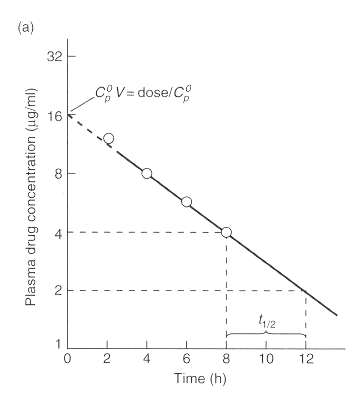|
-
Volume of distribution (Vd) is the ratio between the amount of drug in body (dose given) and the concentration of the drug (C) measured in blood or plasma.
-
Vd = (amount of drug in body)/C where C is the concentration of drug in blood or plasma.
-
Vd as calculated is an apparent volume of distribution. For example:
-
Vd for digoxin is 440 L/70 kg (liters per 70 kg person)
-
Vd for chloroquine is 13,000 L/70 kg (liters per 70 kg person)
-
Such very large Vd would be consistent with very high tissue binding, leaving little free in plasma or blood
-
-
Vd is an apparent volume of distribution, since Vd is the volume needed to contain the amount of drug homogeneously at the concentration found in the blood, plasma, or plasma water.
-
Many drugs have a much higher concentration in extravascular compartments (therefore these drugs are NOT homogeneously distributed)
-
-
-
Physical volumes (L./kg body weight) for some body compartments
-
Water
-
Total Body Water (0.5-0.7 L/kg) or about 35000 to 49000 ml (70 kg individual)
-
Extracellular Water (0.2 L./kg)
-
Blood (0.08 L./kg);
-
Plasma (0.04 L./kg)
-
-
Fat
-
0.2 - 0.35 L./kg
-
-
Bone
-
0.07 L/kg
-
-
|
|
|
-
Factors influencing the volume of distribution:
-
Drug pKa
-
Extent of drug-plasma protein binding
-
Partition coefficient of the drug in fat (lipid solubility)
-
Vd may be affected by:
-
Patient's gender
-
Patient's age
-
Patient's disease
-
Patient's body composition
-
-
Example of a poorly lipid soluble agent with a Vd about equal to extracellular fluid volume: nondepolarizing neuromuscular blocking drugs.
-
Stoelting, R.K., "Pharmacokinetics and Pharmacodynamics of Injected and Inhaled Drugs", in Pharmacology and Physiology in Anesthetic Practice, Lippincott-Raven Publishers, 1999, 1-17.
Dolin, S. J. "Drugs and pharmacology" in Total Intravenous Anesthesia, pp. 13-35 (Nicholas L. Padfield, ed), Butterworth Heinemann, Oxford, 2000
